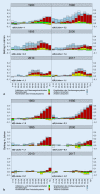[30 years of German unification: achievements and remaining differences in mortality trends by age and cause of death]
- PMID: 33765247
- PMCID: PMC8060242
- DOI: 10.1007/s00103-021-03299-9
[30 years of German unification: achievements and remaining differences in mortality trends by age and cause of death]
Abstract
Background: During the German division, two culturally very similar populations were exposed to very disparate socioeconomic conditions, which converged again after 1989. The impact of healthcare and life circumstances on mortality differences can better be estimated when cultural explanations are widely neglectable.
Objectives: For the first time, we analyse harmonised cause-of-death data explicitly by age. Hereby, we can show which ages or birth cohorts were particularly affected by German division and reunification in their mortality and to which causes of death this is attributable.
Materials and methods: We harmonised the German cause-of-death statistics by applying an internationally standardised harmonisation process to account for differences and breaks in cause-of-death coding practices. We analysed the data using decomposition methods.
Results: During the 1980s, east-west disparities were increasing as progress in the reduction of cardiovascular mortality was much stronger in West Germany, notably at older ages. After 1989, East Germany was able to catch up to the west in many areas. This is especially true for elderly persons and women, while east-west disparities are still visible today, particularly among male adult cohorts (1950-1970) strongly affected by the East German transition crisis.
Conclusions: The lower life expectancy of the East German population in the late 1980s was primarily caused by a slower pace of the cardiovascular revolution. The remaining present-day disparities are rather an aftermath of the East German transition crisis than direct aftereffects of the division.
Zusammenfassung: HINTERGRUND: Durch die deutsche Teilung wurden 2 kulturell sehr ähnliche Bevölkerungen sehr unterschiedlichen sozioökonomischen Bedingungen ausgesetzt, die sich nach 1989 wieder anglichen. Der Einfluss von Gesundheitsversorgung und Lebensumständen auf Sterblichkeitsunterschiede kann besser erfasst werden, wenn kulturelle Erklärungen weitgehend ausgeblendet werden können.
Ziel der arbeit: Die Arbeit wertet harmonisierte Todesursachendaten erstmals detailliert nach Alter aus. Hierdurch kann aufgezeigt werden, welche Alter bzw. Geburtsjahrgänge besonders stark durch die deutsche Teilung und Wiedervereinigung in ihrer Mortalität beeinflusst wurden und auf welche Todesursachen dies zurückzuführen ist.
Material und methoden: Die deutschen Todesursachenstatistiken wurden einem international standardisierten Harmonisierungsverfahren unterzogen, um Unterschieden und Brüchen in der Todesursachencodierung Rechnung zu tragen. Die Daten wurden mit Dekompositionsmethoden analysiert.
Ergebnisse: In den 1980er-Jahren stiegen die Ost-West-Unterschiede stark an, da Westdeutschland gerade in höheren Altern deutlich höhere Rückgänge bei der kardiovaskulären Mortalität erzielen konnte. Nach 1989 konnte Ostdeutschland in vielen Bereichen zum Westen aufholen. Dies gilt besonders für ältere Personen und Frauen, während gerade bei den stark von der ostdeutschen Transformationskrise betroffenen männlichen Geburtsjahrgängen (1950–1970) noch heute Ost-West-Unterschiede sichtbar sind.
Diskussion: Die geringere Lebenserwartung der ostdeutschen Bevölkerung Ende der 1980er-Jahre war primär durch Rückstände bei der kardiovaskulären Revolution bedingt. Die noch heute bestehenden Unterschiede sind eher Spätfolgen der ostdeutschen Transformationskrise als direkte Spätfolgen der Teilung.
Keywords: Decomposition analysis; East Germany; German reunification; Life expectancy; West Germany.
Similar articles
-
Changing mortality patterns in East and West Germany and Poland. II: short-term trends during transition and in the 1990s.J Epidemiol Community Health. 2000 Dec;54(12):899-906. doi: 10.1136/jech.54.12.899. J Epidemiol Community Health. 2000. PMID: 11076985 Free PMC article.
-
Changing mortality patterns in East and West Germany and Poland. I: long term trends (1960-1997).J Epidemiol Community Health. 2000 Dec;54(12):890-8. doi: 10.1136/jech.54.12.890. J Epidemiol Community Health. 2000. PMID: 11076984 Free PMC article.
-
How many years of life did the fall of the Berlin Wall add? A projection of East German life expectancy.Gerontology. 2013;59(3):276-82. doi: 10.1159/000346355. Epub 2013 Feb 12. Gerontology. 2013. PMID: 23407046
-
The contribution of medical care to changing life expectancy in Germany and Poland.Soc Sci Med. 2002 Dec;55(11):1905-21. doi: 10.1016/s0277-9536(01)00320-3. Soc Sci Med. 2002. PMID: 12406460
-
What can reunification of East and West Germany tell us about the cause of the allergy epidemic?Clin Exp Allergy. 2015 Jan;45(1):94-107. doi: 10.1111/cea.12458. Clin Exp Allergy. 2015. PMID: 25412814 Review.
Cited by
-
Healthy enough to work up to age 67 and beyond? A longitudinal population-based study on time trends in working life expectancy free of cardiovascular diseases based on German health insurance data.BMJ Public Health. 2024 Jan 4;2(1):e000400. doi: 10.1136/bmjph-2023-000400. eCollection 2024 Jun. BMJ Public Health. 2024. PMID: 40018198 Free PMC article.
-
[Private Prescriptions In East And West Germany - A Secondary Data Analysis].Gesundheitswesen. 2023 Dec;85(12):1213-1219. doi: 10.1055/a-2160-2679. Epub 2023 Dec 11. Gesundheitswesen. 2023. PMID: 38081175 Free PMC article. German.
-
What Determines That Older Adults Feel Younger Than They Are? Results From a Nationally Representative Study in Germany.Front Med (Lausanne). 2022 Jun 28;9:901420. doi: 10.3389/fmed.2022.901420. eCollection 2022. Front Med (Lausanne). 2022. PMID: 35836953 Free PMC article.
-
[Characteristics of applicants with first-time determination of need for long-term care-A nationwide analysis of care assessments of applicants insured with the AOK aged 60 years and above].Z Gerontol Geriatr. 2025 Feb;58(1):46-54. doi: 10.1007/s00391-024-02344-x. Epub 2024 Aug 27. Z Gerontol Geriatr. 2025. PMID: 39222256 Free PMC article. German.
-
[Healthier at work for longer? Trends in life years free of cardiovascular and musculoskeletal diseases in the employed and general population based on health insurance claims data].Bundesgesundheitsblatt Gesundheitsforschung Gesundheitsschutz. 2024 May;67(5):555-563. doi: 10.1007/s00103-024-03868-8. Epub 2024 Apr 12. Bundesgesundheitsblatt Gesundheitsforschung Gesundheitsschutz. 2024. PMID: 38607434 Free PMC article. German.
References
-
- Pechholdová M, Grigoriev P, Meslé F, Vallin J. Have live expectancies in eastern and western Germany converged since reunification? Popul Soc. 2017;544:1–4.
MeSH terms
LinkOut - more resources
Full Text Sources
Other Literature Sources




